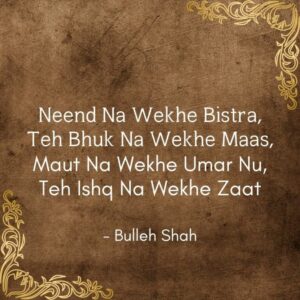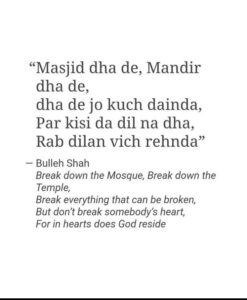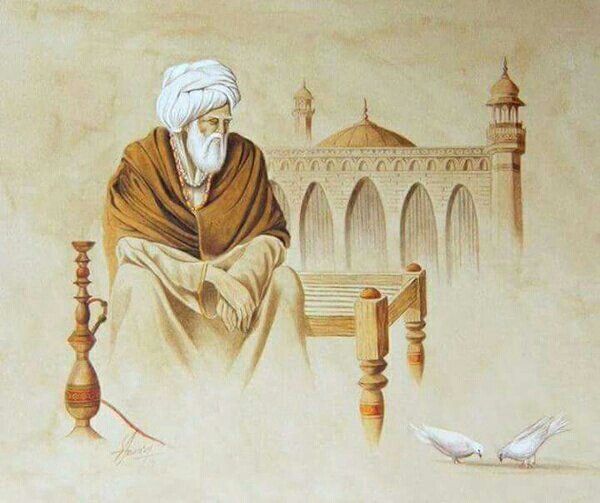Baba Bulleh Shah: Let’s Walk You Through The Voice That Echoes Through Time
Some voices refuse to be drowned out by centuries. Some words, written in an era long past, still pierce through modern chaos, carrying the weight of wisdom, rebellion, and love. Syed Abdullah Shah Qadri, the soul we know as Bulleh Shah, was one such poet—a Sufi mystic, a seeker of truth, and a fearless challenger of societal norms. His verses, raw and piercing, continue to resonate with those who dare to question, those who refuse to conform, and those who seek love beyond the material world.
The Journey of a Mystic
Born in 1680 in Uch, Punjab, Bulleh Shah found himself drawn to the Sufi path early in life. He studied under Inayat Shah Qadri, a revered Sufi saint, a decision that led him to both enlightenment and ostracization. His defiance of rigid religious dogma made him a heretic in the eyes of the orthodox, but his poetry—imbued with divine love—made him eternal in the hearts of many.
His works are drenched in themes of unity, love, and the quest for a higher truth. Bulleh Shah spoke of self-annihilation, stripping away ego, and merging with the divine. His words often carried scorn for religious hypocrisy and the emptiness of rituals without true devotion. His life, much like his poetry, was a proof to his defiant spirit—one that bowed only to love.
The Best of Bulleh Shah
Here are some of his most celebrated works, each carrying the depth of his spiritual journey and the fire of his resistance:
1. Bulla Ki Jaana Main Kaun
A soul-searching masterpiece, this poem questions identity beyond worldly labels. It rejects the rigid structures of caste, religion, and hierarchy, embracing the boundless nature of human existence.
Bulla ki jaana main kaun?
(I know not who I am)
This verse alone is a doorway to deep introspection, challenging every assumption of selfhood.
2. Mera Piya Ghar Aaya
A metaphor for divine union, this ecstatic poem celebrates the long-awaited arrival of the beloved (the divine). It is sung in qawwali traditions, bringing alive the joy of spiritual realization.
3. Tere Ishq Nachaya
One of his most powerful verses, it describes how love has turned him into a madman, making him dance in divine ecstasy. This poem reflects the surrender of ego and the ultimate submission to love.
4. Ranjha Ranjha Kardi
Deeply inspired by the legendary Punjabi folk tale of Heer-Ranjha, Bulleh Shah identifies himself with Ranjha, the eternal lover, symbolizing the soul’s yearning for the divine.
Ranjha Ranjha kardi ni main aape Ranjha hoyi
(Chanting Ranjha’s name, I became Ranjha myself)
It speaks of the dissolution of the self into the beloved, blurring the lines between lover and beloved, seeker and sought. Read all of these in detail here.
5. Parh Parh Alam Fazal Hoya
A sharp critique of empty scholarship, this poem ridicules those who hoard knowledge but lack wisdom. It emphasizes the futility of mere book-learning without spiritual realization.

Bulleh Shah in Music
His poetry has found its way into contemporary music, keeping his legacy alive. Some well-known songs featuring his verses include:
- Bulla Ki Jaana – Rabbi Shergill (Fusion/Rock)
- Tere Ishq Nachaya
- Bandeya Ho
- Ranjha Ranjha – Nusrat Fateh Ali Khan (Qawwali)
- Aik Alif – Noori & Saeen Zahoor, featured in Coke Studio Pakistan
Click Here to listen top 10 by Bulleh Shah Baba
Some of his best couplets are
- On the Nature of Love and Separation:
– “Bulleya ki jaana main kaun, na main moman vich masjid, na main vich kaafiraan da jahan.”
– Translation: “Bulleh, I know not who I am; I am neither in the mosque of the believers nor in the world of the infidels.” - On the Quest for Truth:
– “Tere ishq nachaya kar ke thaya thaya.”
– Translation: “Your love has made me dance in ecstasy.” - On the Illusion of Identity:
– “Mitti da putla, mitti vich mil jaana.”
– Translation: “I am a lump of clay, destined to merge back into the earth.” - On the Unity of Existence:
– “Saa’nu ki janaa, tu ki janaa, sa’nun taan jind jaan.”
– Translation: “What do I know, and what do you know? We are but life itself.” - On Spiritual Awakening:
– “Jin ne dard na kita, ohna da ki kita.”
– Translation: “Those who have not felt pain, what can they understand?”

Bulleh Shah Shayari
- Chal Bullia Hun Othay Chalye Jithay Saray Anay
Na Koi Sanu Penchany Na Koi Sanu Manny - Bure Banday Nu Main Laban Turya Par Bura Laba Na Koi
Jad Main Andar Jhati Pai Te Main Tu Bura Na Koi - Bure Banday Nu Main Laban Turya Par Bura Laba Na Koi
Jad Main Andar Jhati Pai Te Main Tu Bura Na Koi
“Zeher vekh ke peeta ,Te ki peeta.
Ishq soch ke keeta ,Te ki keeta.
Dil ee k dil laaiyen di ass, rakhi ve bulleya.
Pyaar vi laalach naal keeta , te ki keeta.”
- Us ka deewana hoon uss ko mehboob hoon,
Kya yeh Kam hai Ke us Se monsoon hoon. - Jo Kuch Sade Ander Wasse, Zaat Sadi Soyi
Jis Dey Naal Mein Nunh Lgaya, Aoho Jesi Hoyi - Ranjha Mein Wich, Mein Ranjhe Wichh, Ghair Khayal Na Koi
Mein Nahi, Aoh Aap Hai, Apni Aap Kare Diljoi - Chitti Chadar La Sut Kurye, Pehn Faqeeran Loyi
Chitti Chadar Dagh Lakesi, Loyi Dagh Na Koi - Neend Na Wekhe Bistra,
Teh Bhuk Na Wekhe Maas,
Maut Na Wekhe Umar Nu,
Teh Ishq Na Wekhe Zaat - Haji Lok Makke no Janday
Asi Janan Takht Hazaray
Jit Dil Yar Atay Dil Kaaba
Sadain Phol Kitaban Charay
Ni Main Kamli Aan - Parh Parh Aalim Fazal Hoya
Kadi Apnay Aap Nu Parhya Ai Nai
Ja Ja Warda Masjidan Mandran Andar
Kadi Man Apnay Wich Warya Ai Nai
The Relevance of Bulleh Shah Today
In an age of rigid identities, political divides, and soulless routines, Bulleh Shah’s words serve as a call to break free. He challenges us to abandon dogma, to embrace love as the highest path, and to recognize the divine in every being. His poetry is not just literature—it is resistance, it is transcendence, it is a roadmap to the soul’s liberation.
The Eternal Flame
Bulleh Shah left this world in 1757, but his poetry remains an undying flame. His grave in Kasur, Pakistan, is a place of reverence where his followers still gather, singing his kalam, keeping his spirit alive. His defiant voice, steeped in divine love, will never be silenced.
Follow Crimson Column for more journeys into the lives and legacies of thinkers and artists.


Оформиление дипломов ВУЗов в Москве — с печатями, подписями, приложением и возможностью архивной записи (по запросу).
Документ максимально приближен к оригиналу и проходит визуальную проверку.
Мы гарантируем, что в случае проверки документа, подозрений не возникнет.
– Конфиденциально
– Доставка 3–7 дней
– Любая специальность
Уже более 2092 клиентов воспользовались услугой — теперь ваша очередь.
Купить государственный диплом — ответим быстро, без лишних формальностей.
yji2fq
Быстро заказать диплом любого ВУЗа!
Заказ официального диплома через надежную фирму дарит ряд достоинств для покупателя. Купить диплом об образовании у сильной организации: doks-v-gorode-petrozavodsk-10.online
Купить диплом ВУЗа по выгодной цене возможно, обратившись к проверенной специализированной фирме. Приобрести диплом о высшем образовании: autoclub.getbb.ru/viewtopic.php?f=2&t=1809
Покупка дипломов ВУЗов по всей России и СНГ — с печатями, подписями, приложением и возможностью архивной записи (по запросу).
Документ максимально приближен к оригиналу и проходит визуальную проверку.
Мы гарантируем, что в случае проверки документа, подозрений не возникнет.
– Конфиденциально
– Доставка 3–7 дней
– Любая специальность
Уже более 1387 клиентов воспользовались услугой — теперь ваша очередь.
Смотреть тут — ответим быстро, без лишних формальностей.
3pqr7x
Thanks for the article. Here’s more on the topic https://artcet.ru/
Thanks for the article. Here’s more on the topic https://fotonons.ru/
1xBet—топовый букмекерский сервис,которая предлагаетуникальные возможностиипривлекательные бонусыдля своих пользователей.Независимо от того,вы—начинающий игрокилипрофессионалом,бонусные коды 1xBet—это шансповысить свои шансы на выигрыш.как пользоваться промокодом в — этоособая комбинация символов и цифр,активирующая до 32 500 рублей на счет.Действует это предложениеисключительно для новичковисразу после создания аккаунтаможно получить 130% на первый депозит.Промокоды 1xBet—это не просто бонус, а и преимущества.Они позволяют вам получить дополнительные средства для ставок,что дает вам больше возможностей для выигрыша.Полученные бонусы можно применять в разных форматах ставок,на спорт, казино, покер и другие игры, предлагаемые 1xBet.В результате вы получаете удовольствие и шанс сорвать крупный выигрыш.
Thanks for the article. Here’s more on the topic https://cultureinthecity.ru/
Заказать цветы с доставкой в Москве
Доставка цветов в Москве – это удобный способ порадовать близких. Множество компаний предлагают услуги доставки цветов в Москве, что дает возможность выбрать подходящий вариант.
Перед тем как оформить заказ, необходимо определиться с тем, какие цветы вы хотели бы видеть в букете. Можно выбрать как традиционный букет, так и что-то необычное.
Не забывайте проверять сроки доставки и дополнительные опции, которые могут предложить сервисы. В некоторых компаниях вы можете добавить к своему заказу открытку или дополнительные небольшие презенты.
Очень важно доверять только проверенным компаниям с положительной репутацией. Это гарантирует, что вы получите качественные цветы и обслуживание на высшем уровне.
Thanks for the article. Here’s more on the topic https://imgtube.ru/
Thanks for the article. Here’s more on the topic https://great-galaxy.ru/
Thanks for the article. Here is a website on the topic – https://40-ka.ru/
Thanks for the article. Here’s more on the topic https://shvejnye.ru/
Свадебный букет из гортензий с бесплатной доставкой по Москве — это отличное решение для тех, кто хочет удивить своих близких. Букеты с гортензиями способны добавить романтики и стиля, делая каждое событие особенным.
Букет гортензий с бесплатной доставкой в Москве.
Вы можете заказать доставку букета гортензий в любое время и в любое место в Москве. Каждый букет гортензий создается мастерами флористики с любовью и вниманием.
Гортензии — это цветы, которые легко сочетаются с другими растениями. Эти цветы могут стать стильным акцентом в вашем доме, радующим глаз каждый день.
Не упустите возможность порадовать себя или своих близких роскошным букетом гортензий с доставкой. Сделать заказ букета гортензий с доставкой очень просто и быстро.
Thanks for the article. Here’s more on the topic https://voenoboz.ru/
31h3wy
аренда экскаватора цена за смену аренда экскаватора цена за смену .
Дизайнерская мебель премиум класса — это воплощение изысканного стиля и безукоризненного качества.
Элитная мебель от дизайнеров — это не просто предметы интерьера, а настоящие произведения искусства. Каждая деталь такой мебели продумана до мелочей и отражает уникальный стиль создателя. Премиум мебель становится все более популярной среди ценителей качества.
Thanks for the article. Here’s more on the topic https://kaizen-tmz.ru/
Thanks for the article. Here’s more on the topic https://adventime.ru/
Качественные скины по доступным ценам, на нашем сайте.
акции, не оставят равнодушными.
популярных скинов, что.
в нашем магазине.
по лучшим ценам.
Присоединяйтесь.
коллекционные скины.
страницу.
скрытые сокровища.
актуальную информацию о скинах, что.
Мы предлагаем, на любой вкус.
для успешного шопинга.
эксклюзивные предложения.
Пользуйтесь, чтобы не упустить возможности.
Не забывайте про, помогут вам.
эксклюзивными товарами, которые будут выделять вас.
Покупая у нас, выбираете.
скины, которые были в тренде, с максимальной выгодой.
skin market https://www.superskinscs.com .
телевизор тошиба не включается ремонт телевизоров тошиба – профессиональный ремонт с гарантией качества.
купить аттестаты за 11 класс https://www.arus-diplom2.ru .
Thanks for the article. Here’s more on the topic https://mehelper.ru/
Быстро и просто заказать диплом об образовании!
Покупка официального диплома через проверенную и надежную фирму дарит множество плюсов. Быстро и просто купить диплом о высшем образовании у сильной организации: doks-v-gorode-mahachkala-5.ru
Thanks for the article. Here’s more on the topic https://orenbash.ru/